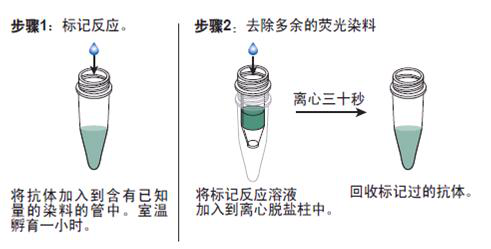
|

| 产地 | 进口、国产 |
| 品牌 | 上海莼试 |
| 保存条件 | Store at -20 °C |
| 货号 | CS10847 |
| 应用范围 | WB=1:100-500 ELISA=1:500-1000 IHC-P=1:100-500 IHC-F=1:100-500 ICC=1:100-500 IF=1:100-500 |
| CAS编号 | |
| 抗体名 | Anti-RASA1 |
| 克隆性 | |
| 靶点 | 详见说明书 |
| 适应物种 | 详见说明书 |
| 形态 | 详见说明书 |
| 宿主 | 详见说明书 |
| 亚型 | IgG |
| 标识物 | 详见说明书 |
| 浓度 | 1mg/1ml% |
| 免疫原 | KLH conjugated synthetic peptide derived from human Ras GTPase-activating protein 1 |
产品订购信息:
英文名称 Anti-RASA1
中文名称 Rho GTP酶激活蛋白1/骨肥大综合征相关蛋白抗体品牌
别 名 Ras GAP; CM AVM; CMAVM; DKFZp434N071; GAP; GTPase activating protein; GTPase-activating protein; OTTHUMP00000222390; OTTHUMP00000222391; OTTHUMP00000222392; OTTHUMP00000222393; p120GAP; p120RASGAP; PKWS; Ras GTPase-activating protein 1; RAS p21 protein activator (GTPase activating protein) 1; Ras p21 protein activator; RASA; RASA1; RASA1_HUMAN; RasGAP; Triphosphatase activating protein.


浓 度 1mg/1ml
规 格 0.2ml/200μg
抗体来源 Rabbit
克隆类型 polyclonal
交叉反应 Human, Mouse, Rat, Chicken, Dog, Pig, Cow, Horse, Sheep
产品类型 一抗
研究领域 细胞生物 信号转导 G蛋白偶联受体 G蛋白信号
蛋白分子量 predicted molecular weight: 116kDa
性 状 Lyophilized or Liquid
免 疫 原 KLH conjugated synthetic peptide derived from human Ras GTPase-activating protein 1
亚 型 IgG
纯化方法 affinity purified by Protein A
储 存 液 Preservative: 15mM Sodium Azide, Constituents: 1% BSA, 0.01M PBS, pH 7.4
Rho GTP酶激活蛋白1/骨肥大综合征相关蛋白抗体品牌 产品应用 WB=1:100-500 ELISA=1:500-1000 IHC-P=1:100-500 IHC-F=1:100-500 ICC=1:100-500 IF=1:100-500
(石蜡切片需做抗原修复)
not yet tested in other applications.
optimal dilutions/concentrations should be determined by the end user.
保存条件 Store at -20 °C for one year. Avoid repeated freeze/thaw cycles. The lyophilized antibody is stable at room temperature for at least one month and for greater than a year when kept at -20°C. When reconstituted in sterile pH 7.4 0.01M PBS or diluent of antibody the antibody is stable for at least two weeks at 2-4 °C.
Important Note This product as supplied is intended for research use only, not for use in human, therapeutic or diagnostic applications.
产品介绍 The mammalian c-H-, c-K- and N-Ras proto-oncogenes encode ubiquitously expressed proteins (1,2). p21Ras can exist in either a physiologically quiescent GDP-binding state or a GTP-binding signal-emitting state (3). Oncogenic p21Ras proteins are trapped in the excited signal-emitting state because the mechanism normally employed to delimit their excitation period, hydrolysis of their bound GTP to GDP, is impaired as a result of specific mutations (3). Interaction of p21Ras with GTPase activating protein (GAP) can increase hydrolysis of p21Ras-bound GTP by as much as 1000-fold (4,5). The product of the neurofibromatosis type 1 gene (NF1) has also been shown to exhibit p21Ras GAP activity (6,7), and proteins that stimulate the GTPase activity of three other low molecular weight GTPases, including Rho, Rab 3A and Rap 1, have also been described (8,9).
Function : Inhibitory regulator of the Ras-cyclic AMP pathway. Stimulates the GTPase of normal but not oncogenic Ras p21.
Subunit : Interacts with SQSTM1. Interacts with SPSB1; the interaction does not promote degradation. Interacts with CAV2 (tyrosine phosphorylated form). Directly interacts with NCK1. Interacts with PDGFRB (tyrosine phosphorylated). Interacts (via SH2 domain) with the 'Tyr-9' phosphorylated form of PDPK1.
Subcellular Location : Cytoplasm.
Tissue Specificity : In placental villi, detected only in the trophoblast layer (cytotrophoblast and syncytiotrophoblast). Not detected in stromal, endothelial or Hofbauer cells (at protein level).
DISEASE : Note=Mutations in the SH2 domain of RASA seem to be oncogenic and cause basal cell carcinomas.
Defects in RASA1 are the cause of capillary malformation-arteriovenous malformation (CMAVM) [MIM:608354]. CMAVM is a disorder characterized by atypical capillary malformations that are multiple, small, round to oval in shape and pinkish red in color. These capillary malformations are associated with either arteriovenous malformation, arteriovenous fistula, or Parkes Weber syndrome.
Defects in RASA1 are a cause of Parkes Weber syndrome (PKWS) [MIM:608355]. PKWS is a disorder characterized by a cutaneous flush with underlying multiple micro-arteriovenous fistulas, in association with soft tissue and skeletal hypertrophy of the affected limb.
Similarity : Contains 1 C2 domain.
Contains 1 PH domain.
Contains 1 Ras-GAP domain.
Contains 2 SH2 domains.
Contains 1 SH3 domain.
Database links : UniProtKB/Swiss-Prot: P20936.1

Anti-Smad2/3 /FITC 荧光素标记Smad 2/3抗体IgGMulti-class antibodies规格: 0.2ml
CD19(B-lymphocyte Anti-gen CD19 precursor) CD19(抗原)Multi-class antibodies规格: 0.5mg
寡腺苷酸合成酶-1 Anti-OAS1 0.2ml
Spermine synthase 英文名称: 精胺合成酶抗体 0.1ml
phospho-Ep300 (Ser89) 英文名称: 磷酸化转录接头蛋白EP300抗体 0.1ml
Rhesus antibody Rh phospho-Nrf2 (Ser40) 磷酸化核因子2相关因子2(Ser40)抗体 规格 0.1ml
CD19(B-lymphocyte Anti-gen CD19 precursor) CD19(抗原)Multi-class antibodies规格: 0.5mg
Anti-Insulin/FITC 荧光素标记标记胰岛素抗体IgGMulti-class antibodies规格: 0.2ml
Anti-RUNX1/AML1/FITC 荧光素标记兔抗人、大、小鼠急性髓细胞1蛋白抗体IgGMulti-class antibodies规格: 0.2ml
Rhesus antibody Rh ANKRD53 锚蛋白重复域53抗体 规格 0.2ml
Rabbit Anti-mouse IgG/Cy7 Cy7标记的兔抗小鼠IgG 0.1ml
G protein alpha S 英文名称: G蛋白αS抗体(鸟嘌呤核苷酸结合蛋白Gα s) 0.2ml
Rhesus antibody Rh Rabbit Anti-human IgG F(ab')2/PE-Cy5.5 PE-Cy5.5标记的兔抗人IgG F(ab')2 规格 0.1ml
Anti-RUNX1/AML1/FITC 荧光素标记兔抗人、大、小鼠急性髓细胞1蛋白抗体IgGMulti-class antibodies规格: 0.2ml
Collagen III 大鼠III型胶原Multi-class antibodies规格: 48T
Anti-DLK1 穿膜蛋白DLK1抗体Multi-class antibodies规格: 0.2ml
Rhesus antibody Rh NDRG2 基因NDRG2抗体 规格 0.2ml
Human leukemia inhibitory factor receptor,LIFR ELISA Kit 人抑制因子受体 96T
Slc4a7 英文名称: 碳酸氢协同转运蛋白4-A7抗体 0.2ml
CD93 英文名称: CD93抗体 0.2ml
Anti-DLK1 穿膜蛋白DLK1抗体Multi-class antibodies规格: 0.2ml
PPLOAgar
DRBC培养基 250(g) incubation media DRBC培养基 250(g)
肠道菌增菌肉汤 250g 用于肠道菌的增菌培养
支原体琼脂培养基MycoplasmaAgarMedium用于培养支原体的基础培养基
哥伦比亚培养基 250g 用于多种微生物的增菌培养
PseudomonasAgarMediumforDetectionofPyocyanin
氯化三苯四氮唑-沙保罗培养基 250(g) incubation media 氯化三苯四氮唑-沙保罗培养基 250(g)
GN增菌液 250g 用于革兰氏阴性菌的选择性培养,特别是志贺氏菌和沙门氏菌的增菌培养(GB/T4789.28-2003 中4.17,...
液体大豆酪蛋白消化物培养基SoybeanCaseinDigestMedium用于药品无菌检测
CIN-1添加剂 1ml*5 每支添加于200ml
Rho GTP酶激活蛋白1/骨肥大综合征相关蛋白抗体品牌 玫瑰红琼脂培养基 规格: 250g 用途: 供药品和生物制品中霉菌和酵母菌的计数、分离和培养用。(《中华人民共和国药典》2010年版)
Fraser肉汤增菌液(FB1,FB2)基础 规格: 250g 用途: 用于李斯特氏的选择性增菌培养(SN/T0184.1-2005,ISO标准)。
PALCAM琼脂基础 规格: 250g 用途: 用于单增李斯特氏菌的选择性分离培养(GB 4789.30-2010和SN/T0184-2005)。
牛津琼脂基础 规格: 100g 用途: 用于单核增生李斯特氏菌的选择性分离(SN0184-2005)。

抗体的生物素化标记实验要点:
1. Rho GTP酶激活蛋白1/骨肥大综合征相关蛋白抗体品牌 如在反应混合液中有叠氮钠或游离氨基存在,会抑制标记反应。因此,蛋白质在反应前要对 0.1mol/L碳酸氢钠缓冲液或0.5mol/L硼酸缓冲液充分透析;
2.所用的NHSB及待生物素化蛋白质之间的分子比按蛋白质表面的ε-氨基的密度会有所不同,选择不当则影响标记的效率,应先用几个不同的分子比来筛选最适条件;
3.用NHSB量过量也是不利的,抗原的结合位点可能因此被封闭,导致抗体失活;
4.由于抗体的氨基不易接近可能造成生物素化不足,此时可加入去污剂如 Triton x-100, Tween20等;
5.当游离ε-氨基(赖氨酸残基的氨基)存在于抗体的抗原结合位点时,或位于酶的催化位点时,生物素化会降低或损伤抗体蛋白的结合力或活性;
6.生物素还可能与不同的功能基团,如羰基、氨基、巯基、异咪唑基及*基,也可与糖基共价结合;
7.交联反应后,应充分透析,否则,残余的生物素会对生物素化抗体与亲和素的结合产生竞争作用;
8.在细胞的荧光标记实验中,中和亲和素的本底低,但由于链霉亲和素含有少量正电荷,故对某些细胞可导致高本底。
抗体的鉴定:
1)Rho GTP酶激活蛋白1/骨肥大综合征相关蛋白抗体品牌 抗体的效价鉴定:不管是用于诊断还是用于,制备抗体的目的都是要求较高效价。不同的抗原制备的抗体,要求的效价不一。鉴定效价的方法很多,包括有试管凝集反应,琼脂扩散试验,酶联免疫吸附试验等。常用的抗原所制备的抗体一般都有约成的鉴定效价的方法,以资比较。如制备抗抗体的效价,一般就采用琼脂扩散试验来鉴定。
2)抗体的特异性鉴定:抗体的特异性是指与相应抗原或近似抗原物质的识别能力。抗体的特异性高,它的识别能力就强。衡量特异性通常以交叉反应率来表示。交叉反应率可用竞争抑制试验测定。以不同浓度抗原和近似抗原分别做竞争抑制曲线,计算各自的结合率,求出各自在IC50时的浓度,并按公式计算交叉反应率。
如果所用抗原浓度IC50浓度为pg/管,而一些近似抗原物质的IC50浓度几乎是无穷大时,表示这一抗血清与其他抗原物质的交叉反应率近似为0,即该血清的特异性较好。
3)抗体亲和力:是指抗体和抗原结合的牢固程度。亲和力的高低是由抗原分子的大小,抗体分子的结合位点与抗原决定簇之间立体构型的合适度决定的。有助于维持抗原抗体复合物稳定的分子间力有氢键,疏水键,侧链相反电荷基因的库仑力,范德华力和空间斥力。亲和力常以亲和常数K表示,K的单位是L/mol。抗体亲和力的测定对抗体的筛选,确定抗体的用途,验证抗体的均一性等均有重要意义。